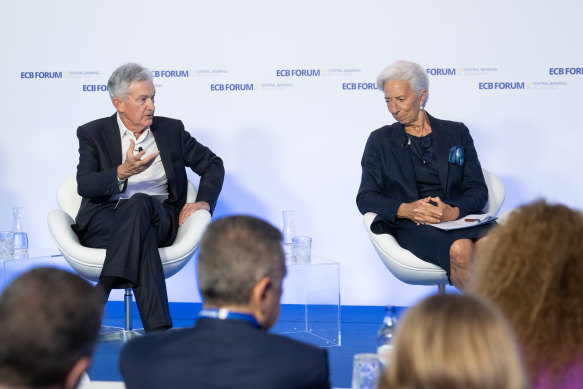Save articles for later
Add articles to your saved list and come back to them any time.
The “last mile” in the fight against inflation, as the Bank of International Settlements describes it, now appears likely to be more painful than anticipated by those in and around the markets, or, until recently, even by the central bankers inflicting the pain.
At a European Central Bank forum in Sintra in Portugal on Wednesday, the major central bank chairs were singing from the same song sheet. The tones were harsh and ominous.
Rates could be higher for longer: US Federal Reserve chairman Jerome Powell with ECB president Christine Lagarde on stage at the ECB Forum in Portugal.
The US Federal Reserve’s Jerome Powell wouldn’t rule out consecutive rate rises at the Fed’s next two meetings; the ECB’s Christine Lagarde signalled that another rate rise in the eurozone next month was a virtual certainty, and the Bank of England’s Andrew Bailey, who presided over a surprise 50 basis point rate rise earlier this month, says the BoE will do whatever is necessary to bring inflation down to 2 per cent.
The odd central banker out was Japan’s Kazuo Ueda who, despite Japanese core inflation running above 4 per cent, seems quite chuffed that his economy has broken out of decades of stagflation.
Powell and Lagarde were definitely on the same page.
“Although (the Fed’s) policy is restrictive, it may not be restrictive enough, and it has not been restrictive for long enough,” Powell said.
And Lagarde explained: “We are seeing a decline in the inflation rate as the shocks that originally drove up inflation wane and our monetary policy actions are transmitted to the economy. But the pass-through of these shocks is still ongoing, making the decline in inflation slower and the inflation process more persistent.”
Headline inflation rates in the economy have fallen significantly from last year’s peaks, but the “core” inflation rate, which exclude volatile food and energy costs, are proving less sensitive to the most aggressive monetary policies adopted in 40 years and are edging down rather than sinking. That’s true, not just for the US, the European Union or the UK, but for most advanced economies, including Australia.
The origins of this inflation outbreak were in the pandemic and its disruptive impact on global supply chains, and were fed by the profligate fiscal policies adopted by fearful governments, which put a lot of cash – with hindsight, too much cash – in households and corporates’ hands.
The boom in consumption meant companies were able to raise their prices to absorb the impact of the spike in their input and energy costs due to the broken supply chains.
Research by the New York Fed has concluded that the key determinant in companies’ pricing decisions is demand. Businesses were able to pass through their increased costs in full in this pandemic-distorted era because customers were prepared and able to pay the higher prices.
There may not be relief in sight for another year or more for increasingly stressed households or companies.
What Lagarde described as the second phase of the inflation process is the response of workers to the big declines in real wages which, in an environment of historically low unemployment in the major economies, is feeding into and sustaining core inflation rates, even as there is emerging evidence in the US, at least, that companies are now seeing some pressure on margins because the monetary policy-imposed stress on households is biting.
It’s the evolving nature of the drivers of inflation that leaves central bankers uncertain about when and where the peak in their rate cycles – their “terminal” rates — will be reached.
The other complication is that monetary policies work with lengthy delays, generally thought to be between a year and 18 months, between the central banks’ actions and their effects. In a rate cycle that began in March last year in the US and in May last year in Australia, that suggests that the full impact of the earliest of the series of rate rises will only now be showing up.
The Fed has raised US rates 10 times and the Reserve Bank has lifted its cash rate 12 times in this cycle, so the most recent decisions might not be fully reflected in the economic outcomes until the second half of next year.
Life as a central banker was never destined to be easy, but the risk of overkill and avoidable recessions, given the duration of those lags, is increasing the longer the cycle of rising rates continues.
Powell said at the forum that he doesn’t expect core inflation to fall to the Fed’s target of 2 per cent until 2025.
That would suggest that, whatever the terminal rate might be in the US (and most of the central bankers appear to share the same view of their responses to this phase of the cycle) it will probably remain there, at an elevated level, until it is clear that the inflation rate will retrace to the target.
There may not be relief in sight for another year or more for increasingly stressed households or companies, with the central bankers making it clear they are prepared to wear recessions in their economies (although the Fed doesn’t expect one) if that ensures inflation doesn’t get entrenched.
Whether they would be prepared to sit by passively while a financial crisis develops is another matter.
The International Monetary Fund’s deputy head, Gita Gopinath, told the central bankers that they may have to accept longer periods of inflation above their targets to avoid a financial crisis.
High debt levels in not just developing economies, but many European governments, have left them vulnerable to another crisis, she said.
It’s not just sovereigns at risk, of course, with households, some highly-indebted corporates and leverage and/or liquidity mismatches within the lightly or unregulated elements of the non-bank and shadow banking sectors potentially posing threats to financial stability.
There’s already been regional bank collapses in the US (and a major one in Europe) and, with commercial real estate under pressure around the world as a result of both interest rates and pandemic-inspired changes to workplaces, those might not be the last of the smaller banks to fall.
The “higher for longer” message that the central bankers were promoting in Portugal carries with it the significant latent risk that the rate at which monetary policies that had been ultra-loose for a decade-and-a-half have tightened, and the degree of the tightening, might precipitate some severe collateral damage, along with the damage to jobs and growth that the bankers are seeing as a necessary prerequisite for lower inflation rates.
The Business Briefing newsletter delivers major stories, exclusive coverage and expert opinion. Sign up to get it every weekday morning.
Most Viewed in Business
From our partners
Source: Read Full Article

